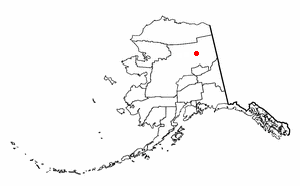Gwichyaa Gwichʼin facts for kids
| Regions with significant populations | |
|---|---|
| Yukon Flats, Alaska, USA | |
| Languages | |
| Gwichʼin, English | |
| Related ethnic groups | |
| Gwich'in |
The Gwichyaa Gwichʼin are a group of Gwich'in people. Their name means "those who dwell on the Flats." They live in the Yukon Flats region of Alaska, USA. This area includes Fort Yukon, which was originally called "Gwicyaa Zhee," meaning "house on the Flats." They also live along the Yukon River and in places like Venetie.
Contents
Who Are the Gwichyaa Gwichʼin?
The Gwichyaa Gwichʼin have been known by many names over time. Some of these names include Fort Indians, Koo-cha-koo-chin, and Lowland people. These different names show how people from other cultures described them. Today, they are mostly known by their original name.
A Look at Their History
The Gwichyaa Gwichʼin are the easternmost group of the larger Gwichʼin family. In the past, there were other important Gwichʼin groups in the Yukon-Porcupine areas. These included the Han, the Natsikutchin, the Tranjikutchin, and the Ventakutchin. Some smaller groups, like the Tatsakutchin and Tennuthkutchin, are no longer around today.
In 1827, a man named Peter Warren Dease from the Hudson's Bay Company learned about the Gwichyaa Gwichʼin. They told him that they were the only tribe who traveled on the Peel River. They would go upstream every year to trade at Arctic Red River. In 1928, an expert named Mooney estimated that about 500 Gwichyaa Gwichʼin lived in the area around 1740.
Their Way of Life and Culture
A long time ago, an anthropologist named Jones studied the Kutchakutchin. He noted they had three main family groups or clans: Tchitcheah, Tengeratsey, and Natsahi. In the past, people had to marry someone from a different clan. This custom eventually changed over time.
The Gwichyaa Gwichʼin were partly nomadic, meaning they moved around. Their main way of life involved hunting animals and trapping furs. After trading posts were set up, they also became important traders. They used strings of beads called Nakieik as a form of money. One string of beads was worth about one or more beaver skins.
Their homes were made from deerskins stretched over curved poles. These homes looked like upside-down teacups. Men usually did the cooking, while women handled other daily tasks. Since they didn't have pottery, they used things like wood, woven mats, animal horns, or bark for dishes and cups. They got metal cooking pots from the Hankutchin people.
Today, the Gwichyaa Gwichʼin still rely on hunting and fishing. They hunt animals like bear, caribou, moose, and waterfowl. They also fish for salmon and whitefish. They earn money by trapping animals and by selling handmade crafts.
Special Recognition
On April 4, 1975, Canada Post released a special stamp. It was called 'Dance of the Kutcha-Kutchin.' This stamp was part of a series about the Indigenous peoples of Canada's Subarctic region. The design came from a drawing made in 1851 by Alexander Hunter Murray. It shows how the Gwichyaa Gwichʼin were recognized for their culture.


